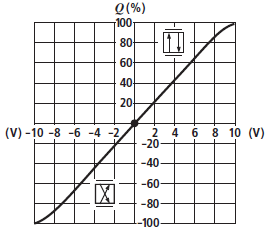The two main types of high-performance hydraulic valves are:
-
Servo-Quality Proportional Valves
Also called high-performace proportional valves. These are more common. Make sure the valve has a ±10V command signal (not 4-20mA). -
Servo Valves (current driven)
Flapper-nozzle, or jet pipe. Often called just servo valves, these require a current input, such as ±50mA. To use these with an RMC, a Current-to-Voltage converter is required, such as the VC2124.
Servo-Quality Proportional Valves
For great performance, trouble-free set-up and machine operation (this means lower startup and maintenance costs), Delta recommends using linear valves with a zero-lapped spool and on-board electronics.
The RMC75E, RMC150E and RMC200 do support non-linear valves (with a single “knee”), but it requires extra set up. A linear valve is the easiest to use.
Linear Valve:
This means the flow vs command signal profile is linear (at least up to about 8 volts):
Terms such as “kink”, “knee”, and “progressive” indicate a non-linear valve.
Zero-lapped spool:
This means the spool is cut so that as soon as a voltage is applied to the valve, hydraulic fluid starts flowing.
On-board electronics:
This means you don’t need to wory about a separate card, and typically, with a good valve, you don’t need to make any adjustments on the electronics.
Important Notice
If you enjoy headaches, choose a valve with an overlapped spool (we call that deadband), and a non-linear flow versus command signal profile. Notice, however, that headaches can result in costs savings. Especially for OEM applications, where you just need to go through the difficulty once, and then pump out volume, it can be well worth it to get a valve that is barely good enough to do the job. On single applications, the time savings in setup usually justify a good valve.
Recommended Servo-Quality Proportional Valves
Here are some valves that Delta knows have been used successfully. Many valves offer +/-10V or 4-20mA input. Make sure to choose +/-10V.
Atos
DLHZO-TEB and DLKZOR-TEB: single-stage, sizes NG6 and 10. The first L in the part numbers indicates a sleeve, which gives more precise control and faster response.
DPZO-LEB: two-stage, sizes 10-35
The EB indicates the Basic Integral digital driver, which is all that is necessary when using the RMC to control the valve.
F180.pdf (1.54 MB)
Bosch Rexroth
4WRREH: Size NG6. Very fast response. Make sure to choose the ±10V command option.
4WRPEH: Sizes NG6 and 10. The NG6 is not as fast as the 4WRREH, but still good. Make sure to choose the ±10V command option.
4WRLE: Sizes 10-35. Make sure to get the V spool with the L (linear) flow characteristic.
Continental
VED03MX: Size D03. Very fast response.
This valve is quite linear, but not perfectly so. Setting the Velocity Feed Forward for a large command voltage typically results in the best tuning.
The VED03MK is not as high performance as the VED0M3X, but will also work quite well.
Domin
The Domin valves S4 Pro, S6 Pro, and S10 Pro all perform very well for position and force control. They have fast step response. The S10 controlled force exceptionally well.
Eaton
Axis Pro valves are very high response and work well for position control, but we have had several reports that they are not suitable for pressure or force control. D03 and D05. Choose level 1 in order to work with the RMC. Make sure to choose the ±10V command option.
K(B)SDG4V-3: http://www.eaton.com/ecm/groups/public/@pub/@eaton/@hyd/documents/content/pll_2105.pdf
Moog
D661: Very fast response and high flow.
D681-D685: Very fast response and high flow.
D633/634: http://www.moog.com/literature/ICD/Moog-Valves-D633_D634-Catalog-en.pdf
D636/637: http://www.moog.com/literature/ICD/Moog-ServoValves-D636_D637-Catalog-en.pdf Less expensive valve with pretty good performance.
79-series: Crazy high response for 200 gpm (750 lpm), and very expensive.
Parker
Very fast response valves with great control.
D1FP: Size NG6. Make sure to choose the ±10V command option.
D3FP: Size NG10. Make sure to choose the ±10V command option.
These valves are quite linear, but not perfectly so. Setting the Velocity Feed Forward for a large command voltage typically results in the best tuning.
The D1FH is not as high performance as the D1FP, but will also work quite well.
Santest DA03S
As of this writing, Santest offers only this one valve, a D05 size, with or without on-board electronics. It is possibly the fastest valve we have tested, and provides exceptional control. The fastest response requires a 48 VDC power supply, and it also supports 24 VDC. The testers say this valve may be the easiest tuning valve they have tried. It tuned a cylinder in pressure control unusually easily. Pressure control is where the differences between valves becomes more pronounced.
Star Hydraulics
Star primarily offers high quality servo valves.
200: Delta has used this valve. It is very small in physical size, 7 lpm, performs well and needs a current output. The VC2124 or RMC200 CA4 module can provide current for this valve.
Make sure to choose a linear zero-lapped spool. If you have a very fast application, choose the high response version.
Most of the sero valves take a current input. However, some of the servo valves have on-board electronics. In this case, choose the ±10 volt option.
Yuken
The LSVG-01-EH and The LSVG-03-EH are crazy high response and linear with on-board electronics. D03 and D05, but maxes out at 60 lpm. Make sure to choose the ±10V command option. Yuken also makes a similar high response D05 valve, the SE1024, with more flow, 130 L/min. In addition, there are two-stage valves with very high flow (up to 3800 lpm) and very fast 0-100% step response (8-13 msec).
For more details, or to suggest a product to be added to this list, send an email to support@deltamotion.com.
